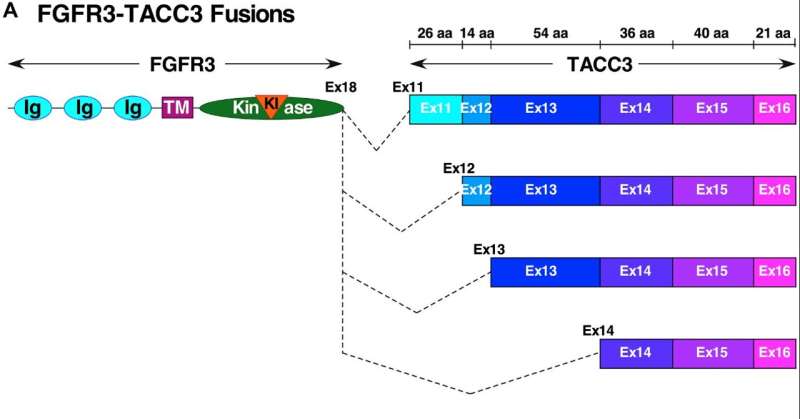This article has been reviewed according to Science X's editorial process and policies. Editors have highlighted the following attributes while ensuring the content's credibility:
fact-checked
peer-reviewed publication
proofread
Oncogenic driver FGFR3-TACC3 requires 5 coiled-coil heptads for activation and disulfide bonds for stability

FGFR3-TACC3 represents an oncogenic fusion protein frequently identified in glioblastoma, lung cancer, bladder cancer, oral cancer, head and neck squamous cell carcinoma, gallbladder cancer, and cervical cancer. Various exon breakpoints of FGFR3-TACC3 have been identified in cancers.
In a recent study, researchers Clark G. Wang, Malalage N. Peiris, April N. Meyer, Katelyn N. Nelson, and Daniel J. Donoghue from University of California San Diego analyzed these FGFR3-TACC3 exon breakpoints to determine the minimum contribution of TACC3 for activation of the FGFR3-TACC3 fusion protein.
"In this work, we characterize the signaling, transforming abilities, and post-translational modifications of FGFR3-TACC3 fusion proteins arising from different exonic breakpoints to determine the requirements for dimerization and constitutive activation of the fusion protein," state the researchers.
While TACC3 exons 11 and 12 are dispensable for activity, the researchers' results show that FGFR3-TACC3 requires exons 13-16 for biological activity. A detailed analysis of exon 13, which consists of 8 heptads forming a coiled-coil, further defined the minimal region for biological activity as consisting of 5 heptads from exon 13, in addition to exons 14-16.
These conclusions were supported by transformation assays of biological activity, examination of MAPK pathway activation, analysis of disulfide-bonded FGFR3-TACC3, and by examination of the Endoglycosidase H-resistant portion of FGFR3-TACC3.
These results demonstrate that clinically identified FGFR3-TACC3 fusion proteins differ in their biological activity, depending upon the specific breakpoint. This study further suggests the TACC3 dimerization domain of FGFR3-TACC3 as a novel target in treating FGFR translocation-driven cancers.
"Taken together, these results provide a better understanding of the mechanism for activation of FGFR3-TACC3 and narrow the scope of targeting TACC3 to create effective dimerization disruption-based therapies for treating patients with FGFR3-TACC3 driven tumors," the researchers conclude.
The paper is published in the journal Oncotarget.
More information: Clark G. Wang et al, Oncogenic driver FGFR3-TACC3 requires five coiled-coil heptads for activation and disulfide bond formation for stability, Oncotarget (2023). DOI: 10.18632/oncotarget.28359





















